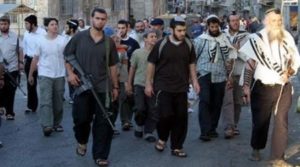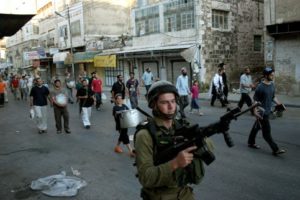“Whatever a soldier believes when they begin their military service, there is no way to behave ethically in the occupied territories. It’s a system in which Palestinians are always treated as inferior, always viewed as the enemy, whoever they are.
“Every day the job is to inflict collective punishment. We were told explicitly that we were waging psychological war, that we were there to intimidate them.\
“In the middle of the night we raided families’ homes, chosen randomly, waking up frightened children. We violently broke up Palestinian protests. I arrested Palestinians every day to ‘dry them out’ – to teach them a lesson, to make them understand who is boss.”
-Ido Evan Paz, former Israeli soldier
Ido Even-Paz, an Israeli Jew, did his tour of duty as a soldier of occupation in the early 2000s. He oppressed Palestinians in occupied Hebron in the service of Jewish settlers and Israel’s strategic objectives in the West Bank.
Today he gives tours of Hebron (in Arabic, al Khalil) on behalf of Breaking the Silence, an organization of former soldiers who have turned their backs on the occupation and its illegal settlement enterprise.
Hebron, roughly 30 kilometers from Jerusalem, is the second largest city in the West Bank and home to between 500 and 900 Jewish settlers, among the most fanatical and violent in the West Bank. They make no bones as to why they are colonizing Hebron: to cleanse it of Arabs and turn it into a Jewish city.
Hebron is the only urban center in occupied Palestine where Jewish settlers live in the heart of it – the Old City, as it is known, was once a thriving and famous Palestinian commercial center. Now it is a ghost town.
According to journalist Jonathan Cook, “For more than 15 years, Israel has forbidden entry for Palestinians to what was once Hebron’s main throroughfare and central shopping area along Shuhada Street. Now it has been rebranded in Hebrew as King David Street, and declared what the army terms a “sterilised area.” The closure severs the main transport routes for Palestinians between north and south Hebron.”
Evan-Paz went to Hebron a young man, eager to test his mettle against Palestinian “terrorists.” Now he goes back to expose the crimes of the occupation and the racist politics of forced separation. He talks bluntly about the systemic nature of oppression under
occupation, debunking the decades-old myth of an Israeli army that “shoots and cries” and is imbued with a high moral calling.
A Fragmented City by Design
There are “two” Hebrons. H1 is the western side of the city. It is nominally under the authority of the Palestinian Authority, but the PA is always subordinate to Israel’s dictates. Most of Hebron’s 230,000 Palestinians reside here.
In the H2 sector, one fifth of the city, between 20,000 and 40,000 Palestinians live. Here settlers and soldiers decide who rules and who obeys. On Hebron’s eastern outskirts is Kiryat Arba, a Jewish-only settlement of 8,000 right-wing, religious Jews.
“The idea is to make life so intolerable the Palestinians will choose to expel themselves,” Even-Paz asserts. “Unemployment among Palestinians is about 70 per cent in H2, so the pressure is on the residents to move into H1 or out of Hebron entirely.”
Palestinians in large numbers have been driven out of the Old City. It’s not hard to understand why. Hebron is dominated by army patrols and snipers on rooftops, and carved up by checkpoints, razor-wire, and watchtowers. Settlers walk the streets like lords of the land, well-armed. They have a colossal appetite for racist persecution, harassment, and brutality. The army is their praetorian guard and Israeli civil law confers immunity on their transgressions.

“They [the settlers] know they are untouchable,” says Even-P
az. “The army’s rules of engagement mean soldiers can’t enforce the law on Israeli civilians. Soldiers are not allowed to respond if the settlers commit a crime or assault a Palestinian. They are even under orders not to shoot back if a settler opens fire at them. When I served, they brought us hot drinks on a cold day, and iced drinks on a hot day. During Shabbat [the Sabbath], they invited us to come and eat in their homes. They became like family to us.”
Jonathan Cook notes that “The few Palestinians still residing in the area [the Old City of Hebron] are literally caged into their own homes – their doors welded shut and their windows covered with bars. The bars are there for their own protection because settlers throw stones, eggs and soiled nappies [translation: shitting diapers] at their windows. The families are forced to enter and leave via the rooftops into back streets to shop, work and meet friends.”
Yet large numbers of Palestinians have insisted on remaining in the Old City, defiant and resilient. Their courageous presence is a form of nonviolent resistance to Israel’s military and settler-colonial project.
Researchers and activists at HebronApartheid.org have correctly observed that “By continuing to live in their houses, take care of their olives trees and walk in the streets inside the H2 area, they [Palestinians] give hope that one day this land will be returned to the local owners. Their resistance keeps the hope alive that Palestinians will one day come back to their homes, the merchants will reopen their shops and Al-Shuhada street will once again turn back into one of the most lively and vivid commercial streets not only in the city of Hebron, but all of the West Bank.”
Additional Resources on Occupied Hebron from Breaking the Silence & Al Jazeera
Soldiers Testimonies from Hebron
Shuhuda Street in Hebron: Dead-End Street
Israeli Settlers Seize Family Homes in Hebron
-Mark Hage, Vermonters for Justice in Palestine

